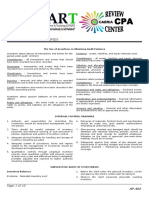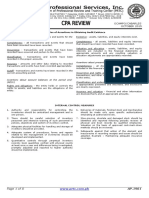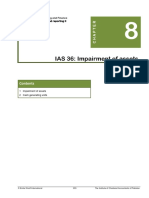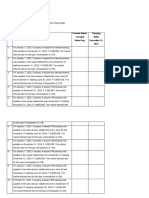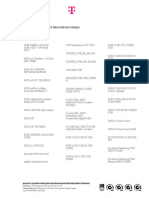Audcap1 Cash Cases Santos
Audcap1 Cash Cases Santos
Uploaded by
Rosette SANTOSCopyright:
Available Formats
Audcap1 Cash Cases Santos
Audcap1 Cash Cases Santos
Uploaded by
Rosette SANTOSOriginal Description:
Original Title
Copyright
Available Formats
Share this document
Did you find this document useful?
Is this content inappropriate?
Copyright:
Available Formats
Audcap1 Cash Cases Santos
Audcap1 Cash Cases Santos
Uploaded by
Rosette SANTOSCopyright:
Available Formats
Concept Map of Cash
Account Cash
Standard(s) PAS 7 Cash Flows shows the historical changes in cash and cash
equivalents during the period. It is an integral part of a complete
set of financial statements and is used in conjunction with other
financial statements in assessing the ability of an entity to
generate cash and cash equivalents, the timing and certainty of
their generation, and the needs of the entity to utilize those cash
flows.
Initial Recognition At initial recognition, an entity measures a financial asset or a
financial liability at its fair value plus or minus, in the case of a
financial asset or a financial liability not at fair value through
profit or loss, transaction costs that are directly attributable to
the acquisition or issue of the financial asset or the financial
liability.
Subsequent Measurement Financial asset or financial liability is measured initially at fair
value. Subsequent measurement depends on the category of
financial instrument. Some categories are measured at
amortized cost, and some at fair value. In limited circumstances
other measurement bases apply, for example, certain financial
guarantee contracts.
Impairment At the end of each reporting period, an entity is required to
assess whether there is any indication that an asset may be
impaired (i.e. its carrying amount may be higher than its
recoverable amount). IAS 36 has a list of external and internal
indicators of impairment. If there is an indication that an asset
may be impaired, then the asset's recoverable amount must be
calculated. [IAS 36.9]
The recoverable amounts of the following types of intangible
assets are measured annually whether there is any indication
that it may be impaired. In some cases, the most recent detailed
calculation of recoverable amount made in a preceding period
may be used in the impairment test for that asset in the current
period: [IAS 36.10]
an intangible asset with an indefinite useful life an intangible
asset not yet available for use goodwill acquired in a
business combination
Derecognition Derecognition questions can arise with respect to all types of
assets and liabilities. This project focuses on financial
instruments. Questions regarding derecognition of assets and
liabilities often arise in the context of certain special purpose
entities and whether those entities should be included in a set of
consolidated financial statements.
FS Assertions - Balance ACERV
Completeness- All assets, liabilities and equity interests
that should have been recorded.
Existence- assets, liabilities and equity interest exist.
Rights and Obligations- the entity holds or controls the
rights to assets, and liabilities are the obligations of the
entity.
Valuation and Allocation- assets, liabilities and equity
interests are included in the financial statements and
appropriate amounts and any resulting valuation or
allocation adjustments are appropriately recorded.
FS Assertions Transactions TOCCAC
Occurrence- transactions and events that have been
recorded have occurred and pertain to entity.
Completeness- all transactions and events that should
have been recorded have been recorded.
Cut-Off- transactions and events have been recorded in
the correct accounting period.
Accuracy- amounts and other data relating to recorded
transactions and events have been recorded
appropriately.
Classification- Transactions and events have been
recorded in the proper accounts.
Audit Risks or Threats Audit risk is made up of two main components, namely the risk
of material misstatement and its respective detection risk.
Risk of Material Misstatement:
Risk of material misstatement can be further broken down by its
own two components, which include:
Inherent risk- risks that can’t be detected or managed by
the organization’s internal controls.
Control risk- risk that an organization’s internal controls
are unable to detect or rectify a significant error or
misstatement within its financial statements.
Detection Risks- possibility of an auditor failing to detect
material misstatements
Controls that should be in Place Key Internal Controls
Segregation of Duties: Authorizing a transaction, the
recording of a transaction and maintaining custody of
the related assets should all be handled by different
personnel.
Accountability: Ensure all cash transactions have been
authorized, have been properly accounted for, and have
been documented properly.
Reconciliations: It is important to reconcile all bank
accounts monthly to ensure all transactions are being
recorded accurately and completely.
Monitoring: A review process is crucial to ensure controls
are in place and running effectively
Appropriate Audit Procedures 1. Conduct a cash count of undeposited collections, petty cash,
and other funds.
Obtain custodian's signature to acknowledge return of items
counted.
Reconcile items counted
Trace undeposited with general
collections countedledger
to bank balances.
reconciliation.
Follow up dispositions of items in cash counted:
a) Undeposited collections should be traced to bank
deposits.
b) Checks accommodated in petty cash should be deposited
after the count to establish their validity.
c) IOUs in the petty cash should be confirmed and traced to
collections in the next payroll period.
d) Expense vouchers should be traced to the succeeding
replenishment voucher.
e) Coordinate cash count with count of marketable securities
and other negotiable assets of the client.
f) Obtain confirmation of year-end fund balances of cash not
counted in branches or other offices.
2. Confirm bank balance by direct correspondence with all banks
in which the client has had deposits and loans during the year.
3. Obtain bank reconciliation.
a) Check arithmetical accuracy of reconciliation.
b) Trace balance per book to the general ledger balance of
cash account.
c) Trace balance per bank-to-bank statement and compare
with amount confirmed by bank.
d) Establish authenticity of reconciling items by reference to
their respective sources, like:
i) Bank debit or credit advice.
ii) Duly approved journal vouchers
e) Investigate checks outstanding for a long period of time.
i) Consider adjustment, especially if the check is already
stale.
ii) Consider the possibility of an erroneous preparation
of the check.
iii) Investigate any unusual reconciling items.
iv) Where internal control over cash is weak, consider
preparing a proof of cash reconciliation.
4. Obtain cutoff bank statement showing the client's
transactions with the bank at least one week after the
reporting date, and:
a) Trace year-end reconciling items, like:
i) Deposit of the year-end undeposited collections.
ii) Completeness of year-end outstanding checks.
iii) Corrections of bank errors.
b) Examine supporting documents of year-end outstanding
checks that did not clear in the cutoff bank statement.
5. Obtain a list of interbank transfers of funds a few days before
and after the reporting date.
a) Vouch supporting documents.
b) Ascertain that the related receipts and disbursements
were booked by the client within the same day or at least
within the same month.
6. Test reasonableness of cutoff by.
a) Comparing dates of checks returned with cutoff bank
statement to dates of recording in the cash disbursements
register.
b) Tracing receipts recorded a few days before the reporting
date to bank deposits.
7. Inspect savings account passbook and certificates of deposits.
a) Reconcile with book balances.
b) Update interest earned posting on passbooks, if
necessary.
c) Compare balances with bank confirmation reply.
8. Determine any restrictions on availability of cash.
9. Determine propriety of financial statement presentation and
adequacy of disclosures
You might also like
- Audit AssertionsDocument3 pagesAudit Assertionsdarknessmind50% (2)
- Audit of Inventories: The Use of Assertions in Obtaining Audit EvidenceDocument9 pagesAudit of Inventories: The Use of Assertions in Obtaining Audit EvidencemoNo ratings yet
- Chapter 9Document3 pagesChapter 9nguyenvy845No ratings yet
- AUDIT - Cash & Cash Equivalent - 20240717 - 165926 - 0000Document6 pagesAUDIT - Cash & Cash Equivalent - 20240717 - 165926 - 0000HazelNo ratings yet
- The Use of Assertions in Obtaining Audit EvidenceDocument7 pagesThe Use of Assertions in Obtaining Audit EvidenceJesebel AmbalesNo ratings yet
- Auditing and AssuranceDocument3 pagesAuditing and AssuranceJñelle Faith Herrera SaludaresNo ratings yet
- 2014 05 PRTC AUDP LECS AP.1601 Audit of Inventories PDFDocument9 pages2014 05 PRTC AUDP LECS AP.1601 Audit of Inventories PDFTed Bryan D. CabaguaNo ratings yet
- 2014 05 PRTC AUDP LECS AP.1601 Audit of Inventories PDFDocument9 pages2014 05 PRTC AUDP LECS AP.1601 Audit of Inventories PDFJericho PedragosaNo ratings yet
- Auditing Problems Ap.402 Audit of Inventories: The Use of Assertions in Obtaining Audit EvidenceDocument10 pagesAuditing Problems Ap.402 Audit of Inventories: The Use of Assertions in Obtaining Audit EvidenceMarjorie PonceNo ratings yet
- Audit AssertionsDocument1 pageAudit AssertionsDevice Factory UnlockNo ratings yet
- Gathering Appropriate Audit Evidence: by Laura Morgan, Examiner - Professional 2 Audit PracticeDocument4 pagesGathering Appropriate Audit Evidence: by Laura Morgan, Examiner - Professional 2 Audit PracticeGodfrey MakurumureNo ratings yet
- Basic Accounting ReviewDocument75 pagesBasic Accounting ReviewSofie SergioNo ratings yet
- AP 1901 Inventories PDFDocument8 pagesAP 1901 Inventories PDFToni Rhys ArguellesNo ratings yet
- Overview of The Financial Statement Audit Process (Final) PDFDocument8 pagesOverview of The Financial Statement Audit Process (Final) PDFMica R.No ratings yet
- PDF 2014 05 PRTC Audp Lecs Ap1601 Audit of InventoriespdfDocument10 pagesPDF 2014 05 PRTC Audp Lecs Ap1601 Audit of InventoriespdfCpaNo ratings yet
- Poa Unit IIIDocument10 pagesPoa Unit IIINILA ANo ratings yet
- AP.3401 Audit of InventoriesDocument8 pagesAP.3401 Audit of InventoriesMonica GarciaNo ratings yet
- 5 Audit EvidenceDocument11 pages5 Audit EvidenceHussain MustunNo ratings yet
- ERC AP 1901 InventoriesDocument8 pagesERC AP 1901 Inventoriesjikee11No ratings yet
- Applicable To Accounts Receivables Assertion Category (CREV) Audit Objectives Audit ProceduresDocument3 pagesApplicable To Accounts Receivables Assertion Category (CREV) Audit Objectives Audit ProceduresRosept ParnesNo ratings yet
- LECTURE 2 - Overview of The Audit Process and Preliminary ActivitiesDocument4 pagesLECTURE 2 - Overview of The Audit Process and Preliminary ActivitiesAlexandra Nicole IsaacNo ratings yet
- Assertions in The Audit of Financial StatementsDocument4 pagesAssertions in The Audit of Financial StatementsAselleNo ratings yet
- Ending Cash Balance EquipmentDocument5 pagesEnding Cash Balance EquipmentMiyuki NakataNo ratings yet
- Assertions Relating To Classes of TransactionsDocument3 pagesAssertions Relating To Classes of TransactionsJay Mar Ortiz JorgioNo ratings yet
- NotesDocument7 pagesNotesHi NameNo ratings yet
- Audit Toolbox - Part 1: Property, Plant and Equipment & CashDocument16 pagesAudit Toolbox - Part 1: Property, Plant and Equipment & CashuserNo ratings yet
- Auditing Problems Ocampo/Cabarles AP.1901-Audit of Inventories OCTOBER 2015Document8 pagesAuditing Problems Ocampo/Cabarles AP.1901-Audit of Inventories OCTOBER 2015AngelouNo ratings yet
- Notes Summary AUE3702 Important NotesDocument72 pagesNotes Summary AUE3702 Important Notessam sigamaNo ratings yet
- Assertion SummaryDocument3 pagesAssertion SummaryAprile AnonuevoNo ratings yet
- Audit of The Acquisition and Payment Cycle: Tests of Controls, Substantive Tests of Transactions, and Accounts PayableDocument33 pagesAudit of The Acquisition and Payment Cycle: Tests of Controls, Substantive Tests of Transactions, and Accounts Payable김현중No ratings yet
- Basic Financial Accounting and Reporting (Bfar) : Philippine Based (Summary and Class Notes)Document22 pagesBasic Financial Accounting and Reporting (Bfar) : Philippine Based (Summary and Class Notes)LiaNo ratings yet
- AP.2901 Inventories.Document9 pagesAP.2901 Inventories.Alarich CatayocNo ratings yet
- Journal 10: Internal Auditing (Auditing and Assurance Principles)Document11 pagesJournal 10: Internal Auditing (Auditing and Assurance Principles)Daena NicodemusNo ratings yet
- 8assertions, Audit Procedures and Audit EvidenceDocument10 pages8assertions, Audit Procedures and Audit EvidenceFranz CampuedNo ratings yet
- SVFC BS Accountancy1Document29 pagesSVFC BS Accountancy1Lorraine TomasNo ratings yet
- Lesson - Substantive ProceduresDocument8 pagesLesson - Substantive ProceduresCherise TrollipNo ratings yet
- Notes ISA 315Document23 pagesNotes ISA 315Sean William CareyNo ratings yet
- CFAS Reviewer TOSDocument16 pagesCFAS Reviewer TOSRyan Malanum AbrioNo ratings yet
- Accounting Assumptions: Introduction To Basic AccountingDocument6 pagesAccounting Assumptions: Introduction To Basic AccountingJon Nell Laguador Bernardo100% (1)
- Chapter 7Document20 pagesChapter 7ddstusiNo ratings yet
- Acctng 9.4 Substantive Tests of Assets (Summary)Document6 pagesAcctng 9.4 Substantive Tests of Assets (Summary)03LJNo ratings yet
- Conceptual FrameDocument28 pagesConceptual FrameNahian HasanNo ratings yet
- Cfas - FinalsDocument28 pagesCfas - Finalsfrincese gabrielNo ratings yet
- CAF 1 SupplementsDocument36 pagesCAF 1 SupplementsAb WasayNo ratings yet
- AT - Materiality and RisksDocument7 pagesAT - Materiality and RisksRey Joyce AbuelNo ratings yet
- Business Network Presentation TemplatesDocument30 pagesBusiness Network Presentation Templateskelewat ambisNo ratings yet
- Assignment - 5: Submitted byDocument10 pagesAssignment - 5: Submitted byShrinkhala JainNo ratings yet
- Module 1: Introduction To Auditing in A Computer Infromation System EnvironmentDocument5 pagesModule 1: Introduction To Auditing in A Computer Infromation System EnvironmentYani IanNo ratings yet
- Sol18 Sebagian2Document11 pagesSol18 Sebagian2Chotimatul ChusnaaNo ratings yet
- Chapter 4 Audit Acquisition and Payment CycleDocument10 pagesChapter 4 Audit Acquisition and Payment CycleyitayihtadNo ratings yet
- Accounting ConceptsDocument3 pagesAccounting ConceptsVic BalmadridNo ratings yet
- IAS 36 Impairment of AssetsDocument22 pagesIAS 36 Impairment of AssetsZeeshan Mahmood100% (1)
- The Financing Cycle Summary, Case Study, AssignmentsDocument18 pagesThe Financing Cycle Summary, Case Study, AssignmentsbernadetteNo ratings yet
- Solution Manual Auditing and Assurance Services 13e by Arens Chapter 18Document35 pagesSolution Manual Auditing and Assurance Services 13e by Arens Chapter 18Thị Hải Yến TrầnNo ratings yet
- Cruz Bsa3b Banking Written ReportDocument17 pagesCruz Bsa3b Banking Written ReportKristine Angeline CruzNo ratings yet
- Conceptual Framew Ork and Accountin G Standards: Justiniano L. Santos, CPA, MBADocument46 pagesConceptual Framew Ork and Accountin G Standards: Justiniano L. Santos, CPA, MBACarmela BuluranNo ratings yet
- Audit of The Capital Acquisition and Repayment CycleDocument21 pagesAudit of The Capital Acquisition and Repayment Cycleilham saputraNo ratings yet
- Financial Reporting MechanicsDocument34 pagesFinancial Reporting Mechanicsb6muddasar100% (1)
- ACCA F8知识要点汇总 (上)Document37 pagesACCA F8知识要点汇总 (上)Freya SunNo ratings yet
- Internal Control of Fixed Assets: A Controller and Auditor's GuideFrom EverandInternal Control of Fixed Assets: A Controller and Auditor's GuideRating: 4 out of 5 stars4/5 (1)
- Busiapp FA2 Part1Document30 pagesBusiapp FA2 Part1Rosette SANTOSNo ratings yet
- Busiapp GT2Document38 pagesBusiapp GT2Rosette SANTOSNo ratings yet
- Confras First Sem LectureDocument52 pagesConfras First Sem LectureRosette SANTOSNo ratings yet
- Intacc2 M2 Ass2Document14 pagesIntacc2 M2 Ass2Rosette SANTOSNo ratings yet
- Confras Mod3&4Document15 pagesConfras Mod3&4Rosette SANTOSNo ratings yet
- NSTP1 Capstone RevisedDocument4 pagesNSTP1 Capstone RevisedRosette SANTOSNo ratings yet
- Readphi Capstone RevisedDocument1 pageReadphi Capstone RevisedRosette SANTOSNo ratings yet
- Intacc1A - M4 Map - SantosDocument3 pagesIntacc1A - M4 Map - SantosRosette SANTOSNo ratings yet
- Requirement 1: Aspect Sole Proprietorship Partnership Corporation 1. DefinitionDocument4 pagesRequirement 1: Aspect Sole Proprietorship Partnership Corporation 1. DefinitionRosette SANTOSNo ratings yet
- Sciteso-MY CARBON FOOTPRINT-1Document1 pageSciteso-MY CARBON FOOTPRINT-1Rosette SANTOSNo ratings yet
- Finma Authorized Asset ManagersDocument10 pagesFinma Authorized Asset Managersoctave bodelNo ratings yet
- SNDT 6 F 231Document10 pagesSNDT 6 F 231Dheer PopatNo ratings yet
- 22 06 2023 - External Fund Transfer - AllDocument17 pages22 06 2023 - External Fund Transfer - Allmeliodas dragonNo ratings yet
- ChallanDocument2 pagesChallansubham shawNo ratings yet
- Baseline TechnologiesDocument11 pagesBaseline TechnologiesSaran M KNo ratings yet
- Acct Statement XX7166 12062023Document5 pagesAcct Statement XX7166 12062023Save EnvironmentNo ratings yet
- Review of Literature:: Definition of Electronic Payment SystemsDocument3 pagesReview of Literature:: Definition of Electronic Payment SystemsAvula Shravan YadavNo ratings yet
- 791 Pi Sobha Limited ADocument1 page791 Pi Sobha Limited AtaniyaNo ratings yet
- Presented By:-: Dhrubajyoti AdakDocument26 pagesPresented By:-: Dhrubajyoti AdakJacob JacobNo ratings yet
- Receivables ExercisesDocument5 pagesReceivables ExercisesChrystelle Gail LiNo ratings yet
- Group 2 Cash Transfer 701pDocument32 pagesGroup 2 Cash Transfer 701pJesa ClemeniaNo ratings yet
- Business-Model-Canvas ENTDocument3 pagesBusiness-Model-Canvas ENTGitanshNo ratings yet
- Wireless LANSDocument3 pagesWireless LANSHOD-DIT PSG-PTCNo ratings yet
- Marketing Strategies of PaytmDocument6 pagesMarketing Strategies of PaytmRethiksha SesurajNo ratings yet
- Beating Online Casinos at BlackjackDocument28 pagesBeating Online Casinos at Blackjackshaialon84No ratings yet
- IRC SP 110-2017 Application of Intelligent Transport System For Urban RoadsDocument74 pagesIRC SP 110-2017 Application of Intelligent Transport System For Urban RoadsjitendraNo ratings yet
- Attitude of Business Students Towards E-Commerce A Case StudyDocument15 pagesAttitude of Business Students Towards E-Commerce A Case StudySamiullah SarwarNo ratings yet
- Untangle Whitepaper Securing The Distributed Enterprise With SD WanDocument3 pagesUntangle Whitepaper Securing The Distributed Enterprise With SD WanRajeev AroraNo ratings yet
- NEEARAJ 2 STTMTDocument4 pagesNEEARAJ 2 STTMTRohit raagNo ratings yet
- Eszkozoket Nem Varjuk VisszaDocument5 pagesEszkozoket Nem Varjuk VisszaTimea LakatosNo ratings yet
- Travel JunkyDocument7 pagesTravel JunkykprdeepakNo ratings yet
- Fee Structure 2021Document5 pagesFee Structure 2021lethabozitha41No ratings yet
- Vodafone Hutchison Australia Pty LTD ABN 76Document8 pagesVodafone Hutchison Australia Pty LTD ABN 76himal91No ratings yet
- 1572420819322Mly2SXEfFDyvuPjo PDFDocument4 pages1572420819322Mly2SXEfFDyvuPjo PDFPraveen Kumar pkNo ratings yet
- Chargeback Antifraud GuideDocument16 pagesChargeback Antifraud Guidetech_archiNo ratings yet
- Asia Direct Logistics (Philippines) - Company ProfileDocument11 pagesAsia Direct Logistics (Philippines) - Company Profilemarketing.teamemyNo ratings yet
- Uhc Consultative Meeting Key Agreements and SynthesisDocument20 pagesUhc Consultative Meeting Key Agreements and SynthesisJoey SanosaNo ratings yet
- Welcome To BPIDocument58 pagesWelcome To BPIMarijobel L. SanggalangNo ratings yet
- How Netflix Is Changing The TV IndustryDocument3 pagesHow Netflix Is Changing The TV IndustryAnna BelleNo ratings yet
- Template 4G NokiaDocument12 pagesTemplate 4G NokiaHouda100% (1)








